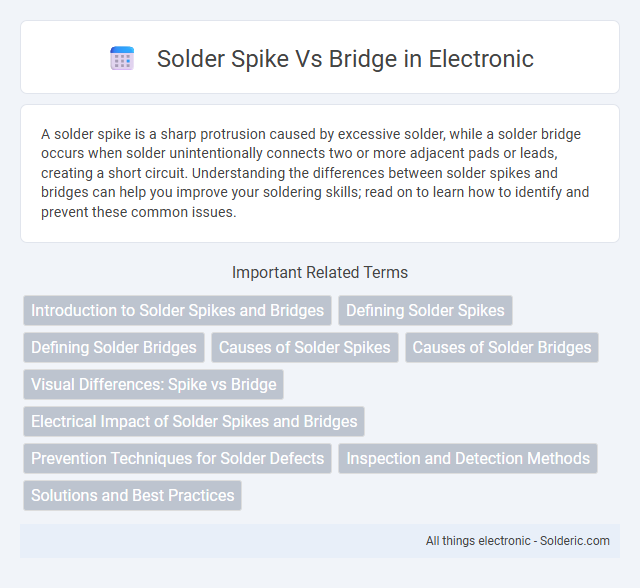A solder spike is a sharp protrusion caused by excessive solder, while a solder bridge occurs when solder unintentionally connects two or more adjacent pads or leads, creating a short circuit. Understanding the differences between solder spikes and bridges can help you improve your soldering skills; read on to learn how to identify and prevent these common issues.
Comparison Table
| Aspect | Solder Spike | Solder Bridge |
|---|---|---|
| Definition | A sharp, unintended protrusion of solder on a pad or joint | An unintentional electrical connection between two or more pads/traces due to excess solder |
| Cause | Excessive solder volume or improper soldering technique | Excess solder flowing and connecting adjacent pads or pins |
| Appearance | Pointed, spike-like solder formation | Flattened, continuous solder connection between components |
| Impact | May cause mechanical weakness or intermittent shorts if contacting other elements | Direct short circuit causing signal failure or permanent damage |
| Detection | Visual inspection, microscopy | Visual inspection, electrical testing (continuity) |
| Correction | Remove excess solder using solder wick or reflow | Remove solder bridge using solder wick, reflow, or manual desoldering |
| Relevance | Common in hand soldering, PCB assembly defects | Critical defect in PCB manufacturing, causing functional failures |
Introduction to Solder Spikes and Bridges
Solder spikes and solder bridges are common soldering defects that affect electronic circuit reliability. A solder spike refers to a sharp, unintended protrusion of solder that can cause short circuits or damage during assembly. In contrast, a solder bridge occurs when excess solder creates an unintended electrical connection between two adjacent pads or leads, leading to potential circuit failures.
Defining Solder Spikes
Solder spikes are sharp, pointed protrusions formed when molten solder accumulates excessively on a joint, often caused by rapid cooling or insufficient flux. These spikes can compromise electrical integrity by creating unintended connections or mechanical stress points. Understanding the difference between solder spikes and bridges helps you maintain high-quality soldering results and avoid potential circuit malfunctions.
Defining Solder Bridges
Solder bridges occur when excess solder creates an unintended connection between two or more conductive pads or leads, causing short circuits in electronic circuits. Unlike solder spikes, which are sharp protrusions of solder often caused by rapid cooling or contamination, solder bridges provide a continuous conductive path that disrupts normal circuit function. Identifying solder bridges is crucial during PCB inspection to prevent malfunction or damage in electronic devices.
Causes of Solder Spikes
Solder spikes are caused primarily by excessive solder application, rapid cooling, or contaminated flux, leading to sharp protrusions on the solder joint. Poor temperature control during the reflow process and improper stencil design also contribute to the formation of solder spikes. Unlike solder bridges, which are formed by solder connecting two adjacent pads, solder spikes result from irregular solder wetting and localized excess solder accumulation.
Causes of Solder Bridges
Solder bridges occur when excess solder causes unintended connections between adjacent pads or pins, often due to insufficient solder mask clearance or poor soldering technique. Common causes include improper temperature control, excessive solder application, and closely spaced components on the PCB layout. Your careful soldering process and precise component placement can significantly reduce the risk of solder bridges.
Visual Differences: Spike vs Bridge
A solder spike appears as a sharp, pointed protrusion on the joint, often resembling a tiny metal needle, while a solder bridge forms a smooth, unintended connection between two adjacent pads or pins. Visually, spikes stand out as isolated, narrow tips, whereas bridges look like thin strips of solder linking separate terminals. Identifying these distinctions helps you troubleshoot circuit boards effectively and ensure reliable electrical connections.
Electrical Impact of Solder Spikes and Bridges
Solder spikes and bridges create unintended conductive paths that cause short circuits, leading to signal integrity issues and potential component damage. Solder spikes can puncture insulating layers or cause intermittent connections, increasing the risk of electrical noise and malfunction. Bridges directly connect adjacent pins or pads, resulting in immediate circuit failures and compromised device reliability.
Prevention Techniques for Solder Defects
Solder spikes and bridges can be effectively prevented by maintaining optimal temperature control and precise solder paste application during the soldering process. Using quality flux and ensuring proper pad design reduces the risk of solder bridging, while controlled solder volume and cleaning prevent solder spikes. Implementing automated inspection systems can help you detect and address these defects early, improving overall PCB reliability.
Inspection and Detection Methods
Solder spike defects are detected through high-magnification optical inspection systems that identify sharp, pointed protrusions on solder joints, often using machine learning algorithms for precise anomaly recognition. Solder bridges are commonly identified via automated X-ray inspection (AXI) and automated optical inspection (AOI), where image processing techniques highlight unintended metallic connections between adjacent pads or leads. Advanced detection combines both AOI and AXI to enhance accuracy by cross-verifying surface anomalies with subsurface structural information, critical for preventing short circuits in PCB assembly.
Solutions and Best Practices
Effective solutions for solder spikes include using proper soldering temperatures and applying flux to prevent excess solder buildup, which helps achieve clean and controlled solder joints. To avoid solder bridges, maintain adequate spacing between pads, employ precise soldering techniques, and use solder wick or desoldering braid for removing accidental bridges. Best practices involve regular inspection with magnification, consistent reflow profiles, and utilizing solder mask to minimize risks of shorts and defects in PCB assembly.
Solder spike vs bridge Infographic

 solderic.com
solderic.com